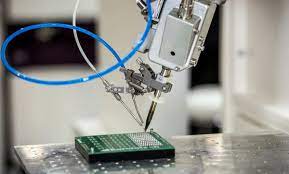Soldering is an essential skill in the world of electronic prototyping. It is the process of joining electronic components to a circuit board using solder, a metal alloy with a low melting point. Whether you are a hobbyist, an engineer, or an inventor, mastering soldering techniques is crucial for creating reliable and functional electronic prototypes. This article will explore the significance of soldering in prototyping and provide valuable tips to achieve soldering success.
The Importance of Soldering in Electronic Prototyping
Soldering is the backbone of electronic prototyping, and for a good reason:
- Electrical Connectivity: Soldered connections provide excellent electrical conductivity, ensuring proper current flow between components.
- Mechanical Stability: Solder joints create strong mechanical bonds between components and circuit boards, preventing disconnections due to vibrations or physical stress.
- Space Efficiency: Soldering allows for compact and efficient circuit designs, making it easier to fit complex electronics into smaller devices.
- Reliability: Properly soldered joints are less likely to fail, leading to more reliable prototypes and reducing the need for frequent repairs.
- Ease of Troubleshooting: Neat and well-done soldering facilitates troubleshooting, as it helps identify potential issues quickly and accurately.
Tips for Successful Soldering
Whether you are a novice or an experienced soldering enthusiast, the following tips will help you achieve soldering success in your electronic prototyping endeavors:
- Invest in Quality Tools: High-quality soldering irons, solder, and other accessories are worth the investment. They provide more precise control and produce better results than low-quality alternatives. You should also invest in quality components, which you can guarantee when you find transistor parts from specialist stores.
- Choose the Right Soldering Iron Temperature: The temperature of your soldering iron should match the solder and components you are using. Delicate components may require lower temperatures to prevent damage, while larger connections may need higher temperatures for effective soldering.
- Cleanliness is Key: Ensure that both the components and the soldering iron tip are clean. Use isopropyl alcohol and a brass sponge or wire mesh to keep the tip clean during the soldering process.
- Tinning the Iron Tip: Before starting to solder, “tin” the soldering iron tip by coating it with a thin layer of solder. This improves heat transfer and makes it easier to solder components.
- Avoid Excessive Heat and Dwell Time: Prolonged exposure to high heat can damage components and PCBs. Apply heat only as long as necessary to melt the solder and create a solid joint.
- Use the Right Amount of Solder: Apply the right amount of solder to form a shiny, concave joint. Insufficient solder can lead to weak connections, while excess solder can cause short circuits or create messy joints.
- Secure Components: Ensure that the components are securely placed during soldering. Use tools like helping hands or a PCB holder to keep the components steady.
- Practice Patience: Soldering is a skill that improves with practice. Don’t rush the process; take time to achieve clean, reliable solder joints.
- Inspect Your Work: After soldering each joint, visually inspect it for defects like cold joints, bridges, or incomplete connections. Use a magnifying glass if needed for a closer examination.
- Learn from Mistakes: Don’t be discouraged by mistakes or imperfect joints. Instead, learn from them and use them as opportunities to refine your soldering skills.
By following these tips and practicing regularly, you can master the art of soldering and elevate your electronic prototyping projects to new heights of quality and reliability.
Conclusion
Soldering is an indispensable skill in electronic prototyping, enabling the creation of robust and efficient circuits. Understanding the importance of soldering and employing the right techniques ensures that your prototypes are functional, reliable, and long-lasting. Remember that practice makes perfect, so don’t shy away from honing your soldering skills and embracing the learning process. Happy soldering, and may your electronic prototypes come to life with precision and finesse!














